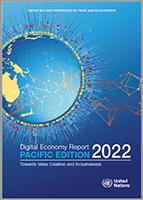Digital Economy Report: Pacific Edition 2022

Digital transformation is under way in the Pacific and presents both opportunities and challenges for the region. Improvements in digital connectivity across the region are converging with growing opportunities for e-commerce, digital payments and digital trade.
For some businesses, electronic commerce is opening access to new domestic, regional and international markets. This is especially important for the Blue Pacific Continent to overcome the ‘tyranny of distance’ inherent in being isolated from global trade networks.
The COVID-19 pandemic magnified the potential of digital technologies to provide solutions to socioeconomic challenges with new ways of working and communicating emerging across the region.
In some countries, the pandemic was a catalyst that sped up long- planned digital initiatives. New mobile money and electronic payment systems accelerated financial inclusion across the region and businesses began turning to online platforms to market and sell their products.
At the same time, we are reminded of the economic and social divides that may be exacerbated by increased digitalization, entrenching both leaders and followers and generating uneven social and economic progress. The digital economy should reduce, not widen, existing income and wealth disparities. The current wave of technological change is unprecedented in terms of speed, scope and scale, and presents the Pacific with a unique opportunity to deliver inclusive digital development that leaves no one behind.
In this context, I am pleased to present the 2022 Pacific Edition of the Digital Economy Report, which aims to strengthen the understanding of digital transformation in the Pacific. While there is no one-size- fits-all solution to address the unique digital challenges faced by the Pacific region, the report provides an overview of the current context and explores how policymakers and local, regional and international organizations can leverage digital technologies for socioeconomic development.
The ongoing adoption of digital technologies in the Pacific is driving complex outcomes that require policy planners and regulators to adopt flexible, adaptive and collaborative approaches. To tap into the tremendous potential of digital transformation in the region, new digital governance models will be needed, as well as the development of comprehensive strategies that build resilience, bridge digital divides and promote economic growth. Inclusion should be placed at the centre of this discussion; all people and sectors should benefit from the digital economy, including rural populations, women, youth and persons with disabilities.
This Pacific Edition of the Digital Economy Report provides a nuanced analysis of the complexities involved in bridging digital divides, as well as important considerations related to value creation and capture in the digital economy. It concludes with a call to move towards a more holistic, coordinated approach to building inclusive digital economies in the region. It identifies future pathways and recommendations to build on, in alignment with national and regional mechanisms and strategies.
Shamika N. Sirimanne
Director, Division on Technology and Logistics UNCTAD


